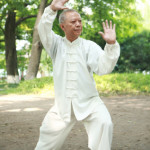 If you remember the original Star Wars® movie it is probably easy to remember the ‘droid C3PO and his strange gait. This android lacked the proper joint arrangement to move in a proper way, which made his walk seem stiff and difficult. But while his spine seemed stiff his knees worked quite well. The reason for this seeming anomaly is that the proper functioning of the knee is critical to effective movement. If the foot strikes the ground at the heel it causes a minor shock all the way up the body. Springy knees allow the foot to hit the ground in a less extreme manner, cushioning the blow by enlarging the area of surface contact.
If you remember the original Star Wars® movie it is probably easy to remember the ‘droid C3PO and his strange gait. This android lacked the proper joint arrangement to move in a proper way, which made his walk seem stiff and difficult. But while his spine seemed stiff his knees worked quite well. The reason for this seeming anomaly is that the proper functioning of the knee is critical to effective movement. If the foot strikes the ground at the heel it causes a minor shock all the way up the body. Springy knees allow the foot to hit the ground in a less extreme manner, cushioning the blow by enlarging the area of surface contact.
From a structural viewpoint the knee should be aligned with the base of the toes in order to maintain balance and front/back stability. If you see that your knee is too far forward you can easily adjust by dropping the knee the knee back, keeping the weight forward, which will give you a lower stance.
Tai Chi offers many different exercises for strengthening the knee and improving its flexibility and mobility. When we use these postures we are able to stimulate our body's natural energies. When our knees become stiff the effects radiate up to the spine and all the way to the neck, and eventually lead to out of alignment vertebras. One of the first signs of bad knee positioning and movement is an ache after practice. This probably means that you are tilting your knees to one side.
Brush Knee, Carry the Tiger to the Mountain, Tiger and Leopard Spring to the Mountain, Twist Step and Bubbling Spring are all excellent Tai Chi springy step sets. The best of these however is the Brush Knee. The three most basic types of Brush Knee are push, press and twist. Push and press develop the anterior and posterior parts of the knee while Brush Twist develops the lateral areas.
- While moving the right hand down and the left hand up turn your body slightly to the left.
- Now a heel first step forward using the left foot. While stepping circle the right hand down past the chest and then back upward to behind the right ear. The left hand is brought back to chest level.
- Now shift your body's weight forward to your leading left foot, bring the right hand back, pushing it forward to nose level, palm outward.
- As you continue to push forward, lower the right hand to waist level, circle it forward palm down and over your left knee.
- Now move you weight back to your right leg and raise your left toes to about a 45 degree angle. When complete shift your weight forward again to your left leg while turning your chest slightly to the left and moving the right hand to the chest.
This exercise can be repeated in reverse order to cover both sides of the body and is excellent for knee conditioning.
